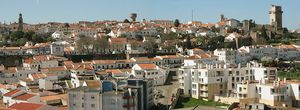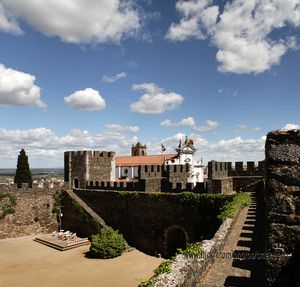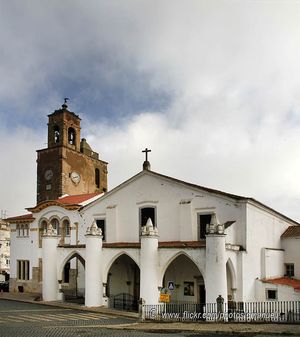
Beja, Portugal
Discover Beja, a charming and not massified city, in Baixo Alentejo, Portugal.
Beja, the main city of Baixo Alentejo, is a quiet and welcoming city. Despite having a beautiful walled centre and fascinating places within walking distance, it does not have many tourists.
Its picturesque squares, good restaurants and inexpensive lodging make it an ideal combination for a relaxing stay and a purely Portuguese experience.
This city is set up in the heart of a touristic regional area known as Planície Dourada (Golden Plain) because it is surrounded by a sea of corn fields.
It is worth visiting the city on a Saturday, because it is when the traditional market is held around the castle.
The best way to discover its charms is by walking through its historical stretch, a nice walk in a city which was a prosperous Roman colony (Pax Julia), headquarter of a Visigothic diocese and it was a Muslim community for five centuries.
If you want to follow an interesting itinerary to discover Benja, you should begin with the landscaped Praça Diogo Fernandes Square, on the edge between the historic stretch and the new city. By a narrow street you go up the the Largos of São João and of the Conceição, where the Sembrano Museological Centre stands, an archeological museum-place with vestiges of the Iron Age, as well as the Igreja Convento da Conceição Church, which hosts the Regional Museum. This church dates from the end of 15th century, but it does show some Manueline features.
Through the large largo dos Duques de Beja you will arrive to the Igreja de Santa Maria da Feira, rebuilt in 15th century or later, with a Gothic entrance-atrium typical of Alentejo. It is also worthy visiting the Sé or Cathedral of Beja, an elegant Mannerist building with interesting blue tiles panels of 18th century.
Once you have visited the cathedral, you should keep going to the Beja Castle with its impressive keep, more than 40 metres in height, which offers the best views of the city and the immensity of the Alentejan plain.
Outside of the walled enclosure, isolated in the middle of a square, is found the Igreja de Santo Amaro Church, which currently hosts the Visigothic Area of the Regional Museum, one of the most important of this period in the Iberian Peninsula.
In the rua Dom Manuel I is found the Hospital da Misericórdia, a Gothic building from the 15th-16th centuries. If you go through the lancet arch hallways, you can visit superficially the entrance courtyard and the inside cluster, with a tank on its centre.
The route finishes in the Praça da República Square, with the restored Manueline Pelourinho in the centre and a big open columnar room, the Igreja da Misericórdia Church, a monument from the Renaissance unique in Portugal.
Other interesting monuments inside the city are the São Francisco Convent, the Ermita de Santo André Hermitage, which are a good example of the Gothic Mudejar style of 15th century and the Igreja dos Prazeres Church, from the Baroque period (18th century) recently restored, adjacent to the Episcopal Museum.
Those who love sculpture shouldn’t miss the Jorge Vieira Museum.
In the suburbs of the city there are two thematic routes: the Roman villas, which comprises the São Cucufate and Pisões, and the one with frescoes, with stations in Alvito (assunção), Cuba (Encarnação), Portel (Siglo Brás) and Vidigueira (São Cucufate Convent.).
Similarly, the surroundings do feature many nice spots, such as:
To the North: Cuba (18 km far), Vidigueira (10 km far from Cuba), villa de Frades with a convent of the Villa Romana de São Cucufate Roman Villa; Alvito (20 kilometres away from Vidigueira) and its castle.
Beja also stands out because it is located in an important wine-making region. Here you can taste its delicious wines, produced in this lands, in any of its 7 wine cellars dedicated to enotourism. The delicious conventual sweets are also something you cannot miss. Its recipes go back to 16th century. Another important aspect, and in this case more original, is the handmade chocolate of Beja, which combines chocolate with the traditional flavours of the region of Alentejo (honey, olive oil, wine, cheese, pennyroyal, and rosemary).
To the South: The Pisões Ruins (10 kilómetros Southeast from Beja), Aljustrel (34 km far) and Castro Verde (at 42 km), Serpa (at 30 km) and Mértola (at 52 km).
Mapa Interactivo:
Beja
What to see:
- Jorge Vieira Museum
- Museu Visigótico (Visigothic Museum)
- Beja Castle
- Beja Regional Museum and Conceição Convent
- Rua do Sembrano Museological Centre
- Beja Episcopal Museum and Igreja dos Prazeres Church
- Beja Botanic Museum
- São Francisco Convent
- Igreja da Misericórdia Church
- Ermida de Santo André Shrine
- Cathedral of Beja
- Cuba
- Insectozoo
- Vidigueira
- São Cucufate Roman villa
- Aljustrel
Other worth-visiting nearby towns and cities:
Why "Portugal Travel"?
Portugal Travel is an organization of Portuguese agencies whose objectives are:
- ✓ To make Portugal, its culture and its heritage known.
- ✓ To promote sustainable tourism.
In collaboration with:
Escola Superior de Hotelaria e Turismo do Estoril
Turismo de Portugal
Copyright PortugalTravel.org © - All rights reserved.






